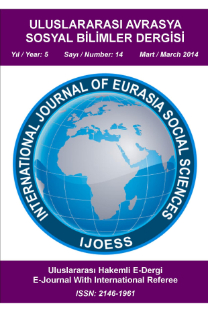WHITHER MACROECONOMICS? THE EVOLUTION OF MACROECONOMIC THOUGHT SINCE KEYNES
___
Allen, F. and Carletti, E. (2010). “The Global Financial Crisis”. Central Bank of Chile Working Papers, 575.Barnett, W. A. (2015). Perspective on the Current State of Macroeconomic Theory. The Theory of Monetary Aggregation, 593-605. Published online: 10 Mar 2015.
Brue, S. L. and Grant, R. R. (2013). The Evolution of Economic Thought. 8 th Edition, South-Western: Cengage Learning, OH.
Chari, V. V. and Kehoe, P. J. (2006). “Modern Macroeconomics in Practice: How Theory Is Shaping Policy”. Journal of Economic Perspectives, 20(4), 3-28.
De Vroey, M. and Malgrange, P. (2011). “The History of Macroeconomics from Keynes’s General Theory to the Present”, IRES Discussion Paper, 2011-28.
Eichenbaum, M. (2010). What Shortcomings in Macroeconomic Theory and Modelling have been Revealed by the Financial Crisis and how should they be addressed in the Future?. Comments from an ECB panel. http://faculty.wcas.northwestern.edu/~yona/research/ECB.pdf. 08 August 2017.
Friedman, M. (1968). “The Role of Monetary Policy”. American Economic Review. 58(1), 1-17.
Goodfriend, M. and King, R. G. (1997). “The New Neoclassical Synthesis and the Role of Monetary Policy”. NBER Macroeconomics Annual, 12, 231-283.
Gordon, R. J. (2000). Macroeconomics. 8 th Edition, New York: Addison-Wesley.
Hicks, J. R. (1937). “Mr. Keynes and the ‘Classics’: A Suggested Interpretation”. Econometrica, 5(2), 147-159.
Ibáñez, C. U. (1999). The Current State of Macroeconomics: Leading Thinkers in Conversation. London: Macmillan Press Ltd.
Keynes, J. M. (1936). The General Theory of Employment, Interest and Money. London: Macmillan.
Koo, R.C. (2016). “The other half of macroeconomics and the three stages of economic development”. Real- World Economics Review, 75, 2-48.
Krugman, P. (2009). “How Did Economists Get It So Wrong?”. The New York Times Magazine, http://www.nytimes.com/2009/09/06/magazine/06Economic-t.html. 12 July 2017.
Kydland, F. and Prescott, E. (1982). “Time to Build and Aggregate Fluctuations”. Econometrica, 50, 1345-1370.
Lucas, Jr. R. E. (1972). “Expectations and the Neutrality of Money”. Journal of Economic Theory, 4(2), 103-124.
Lucas, Jr. R. E. (1976). “Econometric Policy Evaluation: A Critique”. Carnegie-Rochester Conference Series on Public Policy, 1, 19-46.
Lucas, Jr. R. E. and Sargent, T. J. (1979). “After Keynesian Macroeconomics”. Federal Reserve Bank of Minneapolis Quarterly Review, 3(2), 1-16.
Mankiw, G. (1990). “A Quick Refresher Course in Macroeconomics”. Journal of Economic Literature, Vol. XXVIII, 1645-1660.
Milonakis, D. and Fine, B. (2009). From Political Economy to Economics: Method, the Social and the Historical In the Evolution of Economic Theory. Oxon: Routledge.
Modigliani, F. (1944). “Liquidity Preference and the Theory of Interest and Money”. Econometrica, 12(1), 45– 88.
Muth, J. F. (1961). “Rational Expectations and the Theory of Price Movements”. Econometrica, 29(3), 315-35.
O’Brien, D. P. (2004). Classical Economics Revisited. Princeton: NJ- Princeton Univ. Press.
Ouliaris, S. (2012). “Econometrics: Making Theory Count”. Back to Basics: Finance & Development. http://www.imf.org/external/pubs/ft/fandd/basics/econometric.htm, 27 March 2017.
Patinkin, D. (1956). Money, Interest and Prices: An Integration of Monetary and Value Theory. Evanston: IL- Row Peterson.
Phelps, E. S. (1968). “Money-Wage Dynamics and Labor Market Equilibrium”. Journal of Political Economy, 76(4): Part. 2, 687-711.
Samuelson, P. A. (1955). Economics. 3 rd Edition, New York: McGraw-Hill.
Sargent, T. J. and Wallace, N. (1975). “Rational Expectations, the Optimal Monetary Instrument, and the Optimal Money Supply Rule”. Journal of Political Economy, 83(2), 241-54.
Snowdon, B. and Vane, H. R. (2005). Modern Macroeconomics Its Origins, Development and Current State. Cheltenham: Edward Elgar.
Tobin, J. (1958). “Liquidity Preference as Behaviour Towards Risk”. Review of Economic Studies, 25 (2), 65-86.
Woodford, M. (1999). “Revolution and Evolution in Twentieth-Century Macroeconomics”, Prepared for the conference on ‘Frontiers of the Mind in the Twenty-First Century’, Library of Congress, June 14-18, Washington.
Woodford, M. (2008). “Convergence in Macroeconomics: Elements of the New Synthesis”, Prepared for the session ‘Convergence in Macroeconomics?’ at the annual meeting of the American Economics Association, January 4, New Orleans.
- ISSN: 2146-1961
- Yayın Aralığı: 4
- Başlangıç: 2010
- Yayıncı: Prof. Dr. Kadir ULUSOY
EVRİM ÇETİNKAYA YILDIZ, SÜMEYYE DERİN, Almıla Elif SELÇUKLU
EBRU ARAÇ ILGAR, BEKİR BARIŞ CİHAN
EXAMINATION OF SOCIAL APPEARANCE ANXIETY LEVELS OF SENIOR TAEKWONDO ATHLETES STUDYING AT UNIVERSITY
LEVENT VAR, EBRU OLCAY KARABULUT, MURAT ATASOY
TUĞBA CEVRİYE ÖZKARAL, AYŞE MENTİŞ TAŞ
WHITHER MACROECONOMICS? THE EVOLUTION OF MACROECONOMIC THOUGHT SINCE KEYNES
9-11 YAŞ GRUBU ÇOCUKLARDA DİJİTAL OYUN BAĞIMLILIĞININ ARAŞTIRILMASI: KIRŞEHİR İLİ ÖRNEĞİ
CEMRE BOLGÜN, EDİP AYGÜLER, MUSTAFA ÇAĞRI AYALP
AWARENESS LEVEL OF NURSING STUDENTS REGARDING VIOLENCE AGAINST WOMEN – EXAMPLE FROM TURKEY
GÜLSEREN ÇITAK TUNÇ, NEVİN ÇITAK BİLGİN, FATMA ELİF KILINÇ
THE EFFECTIVENESS OF COST-ORIENTED PROJECT MANAGEMENT PROCESS IN BUSINESSES
